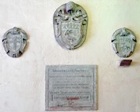
The Roman Porta dell’ Arce, which stands at the highest point in Spello, was probably part of the pre-Augustinian fortifications, and may have been named for an ancient “arx” (citadel). The site was also used for similar purposes by:
-
✴the Lombards, in the 6th century; and
-
✴the Emperor Frederick I, in the 12th century.
It was later the site of the so-called Rocca dell’ Albornoz (see below).
Cassero del Pianello (ca. 1239)
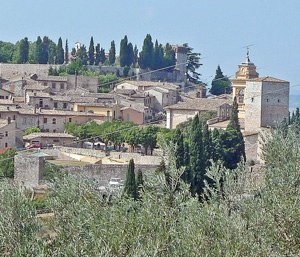
In a bull dated 1258, Pope Alexander IV referred to a building inside Spello “in the place where the Emperor Frederick II built a stronghold”, which he insisted that the reluctant Commune should give to the nuns of Santa Maria di Vallegloria. This is the only surviving document referring to Frederick II as the builder of the so-called Cassero del Pianello. The nuns initially used this as a base within the town walls, and it became the site of their new convent in 1320. (The distinctive campanile of their church is visible to the right in this photograph).
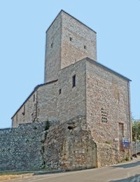
Rocca dell’ Albornoz (1354)
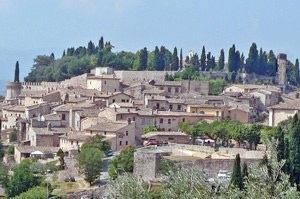
According to the chronicles of the Olorini family, Cardinal Gil Albornoz built a fortress on the site of the old Roman citadel, near San Severino. The date was recorded as 1374: however, Albornoz died in 1367, and the date should probably have been 1354, when Spello submitted to him. Bishop Filippo dell’ Antella of Florence, whom Pope Clement VI had appointed as rector of the Duchy of Spoleto in 1353, and who was recorded in Spello on a number of occasions in 1356-7, presumably resided here. (He commissioned a new fortress in Spello in 1358 - see below).
In 1406, Pope Innocent VII agreed that the position podestà and of castellan of the two fortresses of Spello (this one, which he termed the Rocca del Castello and also the Rocca di Piazza - see below) could be held by the same person, in order to reduce costs.
Two towers from this fortress survives:
-
✴the square tower near Porta dell’ Arce (although the wall with battlements to the right of it was built in 1911); and
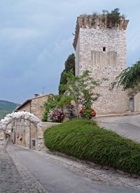
-
✴a circular tower that now forms part of the garden wall of Palazzo Preziosi. This second tower is visible from Piazza Foglie (see Walk II).
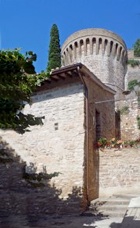
Rocca Baglioni (1358)
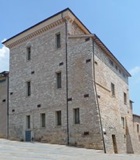

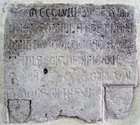
Anno Domini M CCC LVIII
Philippus de Antilla, episcopus Florentius
rector ducatus Spoletani
fecit hedificare istam roccum
tempore domini Innocentii pape VI
This records that, as noted above, the rector Filippo dell’ Antella of Florence had commissioned this fortress in 1358. In fact, Filippo dell’ Antella left the duchy in January 1358 to take up his appointment in Florence, so the commissioning of this fortress must have been among his last acts as rector. In 1359, the podestà of Spello appointed by the papacy recorded that its purpose was “pro statu pacifico tranquillo dicte terre” (to maintain the peace and tranquility of this territory). Its construction seems to have involved involved the demolition of the original Oratorio della Misericordia.
In 1406, Pope Innocent VII agreed that the position podestà and of castellan of the two fortresses of Spello (this one, which he termed Rocca di Piazza, and another one referred to as Rocca del Castello - see above) could be held by the same person, in order to reduce costs.
After Pope Martin V gave Spello to Malatesta Baglioni in 1426, they chose this as their residence. Adriano Baglioni commissioned the Lombard craftsmen Battaglia di Pietro and Filippo di Giacomo to adapt it as his palace in 1561-4. In 1583, this and the adjacent palace were further adapted to serve as the residence of the Papal Governor and the prison.
In 1620, the Seminario San Felice (which Bishop Cardinal Maffeo Barberini of Spoleto, the future Pope Urban VIII, had established in 1611) moved to this site, a fact commemorated in the naming of Via Seminario Vecchio, which runs along the side of the Rocca. The seminary moved to what became the Collegio Vitale Rosi in 1821,
The complex was badly damaged in the earthquake of 1832. The palace originally occupied most of the east side of Piazza della Repubblica, but the part of it to the north (i.e. to the left in this photograph) has been demolished. The surviving part of the palace now forms part of the Scuola Media "Galileo Ferraris".
Remains from Rocca Baglioni
